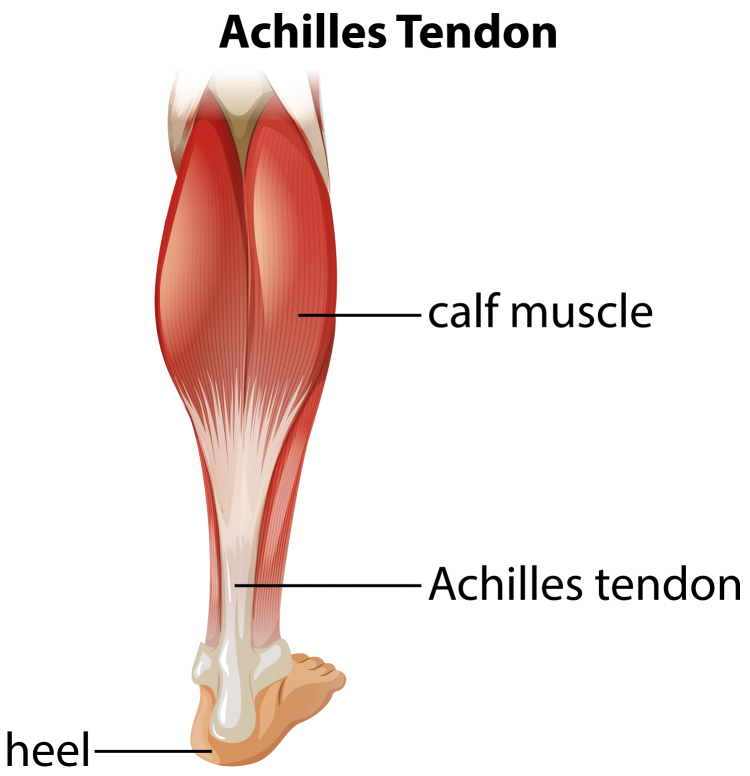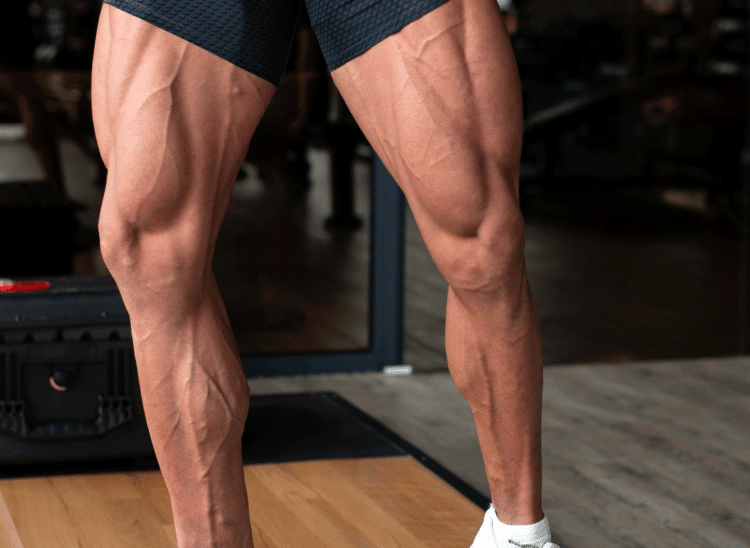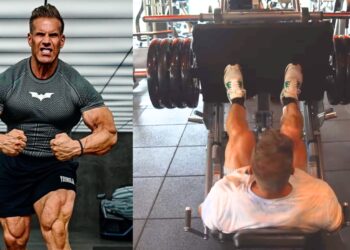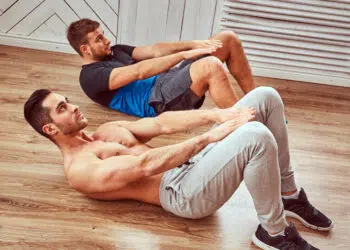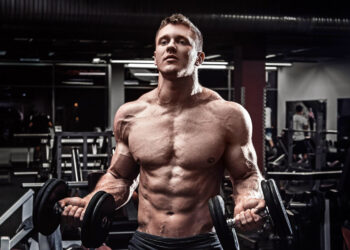For many trainers, the calves are the most stubborn body part; no matter what they do, they just can’t get them to budge.
Your calves should be proportionate to your upper arms and neck. Getting them there is the hard part. The good news is that you don’t need expensive equipment to hammer your calves. In this article, I’ll detail eight dumbbell calf exercises you can do at home. I’ll then put them into not one but three workouts that will give your lower legs no choice but to grow.
Understanding the Calf Muscles
Your calves comprise two parts, the gastrocnemius and soleus. They are generally considered two separate muscles, though some anatomists contend they’re two parts of the same muscle. Either way, they both perform the same function; plantar flexion or extension at the ankle.
The gastrocnemius is the meaty part of the calf that runs from the back of the knee joint to the mid-lower leg. This is the part we usually think of when discussing the calves. The soleus is a flat muscle that lies underneath the gastrocnemius. It has minimal capacity for growth.
Gym lore will tell us that you can and should target the gastrocnemius and the soleus separately for maximum growth. The reality is that 99% of calf growth comes from working the gastrocnemius. Still, the belief persists that straight leg exercises, such as the standing calf raise, emphasize the gastrocnemius, while a bent knee move, like the seated calf raise, switches the focus to the soleus.
This idea arose because the gastroc is more elongated in the standing position. It has less capacity to stretch when doing a seated calf exercise. As a result, some say, the soleus is forced to work harder in this position.
Level Up Your Fitness: Join our 💪 strong community in Fitness Volt Newsletter. Get daily inspiration, expert-backed workouts, nutrition tips, the latest in strength sports, and the support you need to reach your goals. Subscribe for free!
The truth is that a standing version of a calf exercise is simply a better option because it allows for greater gastrocnemius flexion and extension. But that doesn’t mean the soleus is more involved in the seated version.
The Inner and Outer Calf Debate
Another common belief in the bodybuilding world is that you can change the shape of your calves by changing your feet placement while training your lower legs. It is believed that you can prioritize your medial or inner calves by pointing your toes in and your outer or lateral calves by pointing them out.
The truth is that both the inner and outer heads pull on a single Achilles tendon. When you contract the calf muscle, both heads of the gastrocnemius work together to pull the heel bone up. This then produces plantar flexion.
For each head to work independently, it would need its separate tendon and a separate attachment to the heel bone. That would allow each tendon to pull the heel bone in a different direction so that the inner and outer calf can work separately.
But that is not the way we are made. As there is only one tendon, the inner and outer heads of the calf muscle can only pull straight up on that tendon. Turning your toes either in or out will not change anything about that.
The bottom line is that you cannot change the shape of your calves by changing your feet positioning. Your genetics determines that shape. You can make your calves (predominantly the gastrocnemius) bigger, but that’s about it!
The Importance of Range of Motion
As a personal trainer, one of the biggest problems I see with calf training is a restricted range of motion. During just about every visit to the gym, I’ll see someone loading up the entire weight stack on a standing calf machine and then doing a set of short bouncy movements that do a pitiful job of moving the target muscle through its full range of motion.
The goal is not to hoist as much weight as possible. Rather, it is to move the target muscle through its full range of motion under control. You put your feet on a block when doing calf exercises to allow for that full range of motion. It enables the heels to drop lower than the toe level. Yet, I often see guys who don’t even bring their heels down to the block level.
It is far better to use a lighter weight that allows you to move through the full range of motion than to overload the machine or grab a dumbbell so heavy that it doesn’t let you get a full calf stretch.
Benefits of Dumbbell Calf Training
If you’re training at home, using dumbbells to train your calves is probably a matter of necessity rather than choice. There are some good reasons, beyond money or space for a calf raise machine, to choose dumbbells for your lower leg workout.
Let’s check them out:
Level Up Your Fitness: Join our 💪 strong community in Fitness Volt Newsletter. Get daily inspiration, expert-backed workouts, nutrition tips, the latest in strength sports, and the support you need to reach your goals. Subscribe for free!
Better Muscle Isolation
When you use a calf machine, you have to transfer the weight from the stack to the calves. That can place a lot of compressive pressure on your spine. When you’ve got dumbbells in your hands or resting on your knees, you can better transfer them to the lower legs directly.
Full Range of Motion
You are less constricted when doing dumbbell calf exercises compared to calf machines. As a result, you can move through a fuller range of motion for complete contraction and extension.
Unilateral Training
When you work your calves one side at a time with dumbbells, each calf muscle is forced to carry its load. That overcomes the problem of the stronger side taking the bulk of the weight, a common occurrence when using a machine.
Stabilization
Holding dumbbells when doing a standing exercise calls upon your core’s stabilizer muscles for balance.
Exercise Range
Let’s face it; there’s only a little scope for variety when it comes to calf training. But that versatility is far more limited when you use machines; you’ve got standing and seated calf raises, and leg press calf raises, and that’s about it. When you switch to dumbbells, many more possibilities, like those detailed below, open up to you.
8 Dumbbell Calf Exercises
You can do these dumbbell calf-raise exercises at home with quality dumbbells. Use a relatively heavy weight on most exercises to sufficiently stimulate the calves. The exception is the dumbbell box jump, where you should drop the weight by about 50 percent.
1. Dumbbell Calf Raise
The standing dumbbell calf raise should be a mainstay in every calf workout. Doing the exercise in a standing position allows for optimal gastrocnemius stimulation. Using a wood block will allow you to bring your heels lower than the balls of your feet on eccentrics.
Step-by-Step Guide:
- Stand with a pair of dumbbells in your hands and the balls of your feet on a wood block. Your heels should be hanging over the edge.
- Your feet should be shoulder-width apart, and your arms should be at your sides, with your palms facing your body.
- Maintaining a slight knee bend, rise on the balls of your feet to fully extend the calf muscles.
- Hold the top position for a second and then lower under control, bringing your heels lower than the balls of your feet.
- Repeat for the required rep count.
Training Tips:
- Perform a controlled, deliberate movement, both on the way up and the way down.
- Use a weight you can control without losing your grip as the reps progress.
- Keep your core tight and stable throughout the movement.
- Keeping your knees completely straight when doing standing calf exercises can cause pain directly behind your knee. To avoid this, keep a slight knee bend when doing any standing calf movement.
2. Single-Leg Dumbbell Calf Raise
The single-leg dumbbell calf raise is a more challenging variation of the previous exercise. It intensifies the demand on each calf and is a great move to include in your routine if you are concerned about uneven strength or muscle development in your lower legs.
Step-by-Step Guide:
- Stand with a dumbbell in your right hand and your feet on a wood block.
- Bend your left knee and hook your left ankle around your right lower leg so that you are standing on the right leg.
- Maintaining a slight knee bend, rise on the balls of your feet to fully extend the calf muscles.
- Hold the top position for a second and then lower under control, bringing your heels lower than the balls of your feet.
- Repeat for the required rep count.
Training Tips:
- Keep your core tight throughout the movement.
- Do not use momentum on the ascent.
- Exhale on the way up and inhale on the way down.
- Perform this exercise close to a wall for balance.
3. Dumbbell Box Jump
The dumbbell box jump is a plyometric exercise combining explosiveness with resistance. It is a functional move that will challenge your cardio fitness, explosive power, and bodily awareness while working your calves.
Step-by-Step Guide:
- Stand about a foot away from a sturdy plyo box. I suggest starting with a height of 16 inches.
- You should have a dumbbell in each hand, and your feet should be hip-width apart. Maintain a natural, straight posture with your shoulders relaxed and your core tight.
- Hinge your hips and bend your knees slightly.
- Jump up explosively as you swing your arms to produce momentum. Lift both feet simultaneously to jump onto the top of the box.
- Maintain a slight knee bend to absorb the landing impact.
- Stand up tall on top of the box.
- Take a backward step to lower back to the ground.
Training Tips:
- Start with a relatively lightweight, gradually increasing it as you get stronger.
- Take your time stepping down from the box, using a deliberate, controlled movement.
4. Seated Dumbbell Calf Raise
Contrary to what most people think, the seated dumbbell calf raise does not specifically target the soleus. Even though it’s not as effective a gastrocnemius movement as the standing version, it is still a useful move to add to your calf training inventory. It is a stricter movement than a standing calf raise, limiting the use of momentum.
Step-by-Step Guide:
- Place a wood block a few inches in front of the edge of a bench.
- Grab a pair of dumbbells and sit on the edge of the bench with the dumbbells resting on your lower thighs.
- Make sure that your legs are at 90 degrees. Place the balls of your feet on the block so that your heels hang off it.
- Lift your heels as high as you can.
- Hold the top position for a second, savoring the tightness in the calf muscle.
- Lower under control and bring the heel lower than the balls of the feet.
Training Tips:
- Maintain a tight core to stabilize your body.
- Your lower back should be slightly arched to help maintain proper posture.
5. Dumbbell Farmer’s Walk
The dumbbell farmer’s walk is a functional exercise that works your whole body, including the calves. It simply involves walking around with a pair of heavy dumbbells in your hands.
Steps-by-Step Guide:
- Grab a pair of relatively heavy dumbbells and stand with your feet shoulder-width apart and the weights at your sides with a neutral grip.
- Lift your heels slightly off the floor, creating pre-tension in the calves.
- Step forward with your right foot, landing on your heel and rolling through to the balls of your feet.
- Propel forward by pushing the ball of the foot into the ground.
- Continue walking forward, taking ten paces, and then return to the start position.
Training Tips:
- Maintain a tight core to ensure balance and stability.
- Do not shrug your shoulders as you walk forward and back.
- Keep your back naturally arched in the neutral spine position.
6. Dumbbell Reverse Lunge Calf Raise
The dumbbell reverse lunge calf raise is a compound movement that combines reverse lunges and calf raises. It hits the calves, quads, glutes, and hamstrings all at the same time.
Step-by-Step Guide:
- Grab a pair of dumbbells and stand with your feet shoulder-width apart, arms at your sides, held in a neutral position. Maintain a neutral spine with your torso upright. Pull your shoulder blades back and down and lift your chest.
- Take a sizeable backward step with your left foot, descending into a lunge position where both knees are at 90 degrees. Your weight should be evenly distributed between your legs.
- Push through the heel of your right (front) foot as you lift onto the ball of that foot to perform a calf raise.
- Hold the top contracted calf position for a second.
- Lower back down to the lunge position.
- Push through your front thigh to return to the standing position.
- Repeat on the opposite leg.
Training Tips:
- Perform the exerciser at a steady, controlled pace.
- Maintain a neutral spine to prevent back rounding or forward lean.
- Go as deeply into the lunge as you comfortably can.
7. Dumbbell Box Squat Calf Raise
The dumbbell box squat calf raise is a compound movement that combines the traditional squat movement with extra calf muscle engagement.
Step-by-Step Guide:
- Stand before a secure box or bench with dumbbells in your hands, at your sides, and with your palms facing your body. Your feet should be hip-width apart with your toes pointed slightly outward.
- Hinge at the hips and bend your knees to descend into a squat, going down until your butt touches the box or bench behind you. Ensure your spine is neutral (no back rounding) as you go down.
- Push through your heels to come off the box fully erect.
- Rise on your toes to engage the calves. Hold the peak contraction for a second.
- Return to the seated position on the box as you lower your heels.
Training Tips:
- Maintain a neutral spine throughout, with your shoulders pulled back and down and your chest up.
- Use controlled, deliberate movements.
8. Dumbbell Calf Stretch
The dumbbell calf stretch effectively increases the flexibility of the calf while also reducing tension in the meaty part of the gastrocnemius. Dumbbells allow you to get a deeper stretch while also recruiting stabilizer muscles. This is an ideal way to complete your calf workout.
Step-by-Step Guide:
- Grab a relatively light pair of dumbbells and stand on a block with the balls of your feet on it and your heels hanging off the edge.
- Stretch through the balls of your feet to bring your heels as high as possible. Maintain a slight knee bend.
- Hold the extended top position for a 20-second count.
- Lower to bring your heels below your toe level.
Training Tips:
- Use a controlled movement and avoid any jerking, bouncy movement.
- Do not hunch your shoulders.
Creating an Effective Dumbbell Calf Workout Routine
Doing all eight of these calf exercises in a single workout would be massive overkill. You should limit yourself to no more than ten sets to prevent overtraining this relatively small muscle group. I suggest dividing those sets into four exercises, the last one being the dumbbell calf stretch. You should do three sets for the first three exercises and then finish with a single set of the calf stretch.
The calves respond best to relatively high reps. I’ve found that 20 reps per set seem to be the sweet spot for most people. Here are the three different workout options:
Workout One
| Exercises | Sets | Reps |
| DB Standing Calf Raise | 3 | 20 |
| Seated DB Calf Raise | 3 | 20 |
| DB Box Jumps | 3 | 10 |
| DB Calf Stretch | 1 | 20-second hold |
Workout Two
| Exercises | Sets | Reps |
| DB Standing Calf Raise | 3 | 20 |
| DB Box Squat Calf Raise | 3 | 20 |
| DB Box Jumps | 3 | 10 |
| DB Calf Stretch | 1 | 20-second hold |
Workout Three
| Exercises | Sets | Reps |
| DB Standing Calf Raise | 3 | 20 |
| DB Reverse Lunge Calf Raise | 3 | 12 (each leg) |
| DB Farmer’s Walk | 3 | 10 |
| DB Calf Stretch | 1 | 20-second hold |
Conclusion
The calves are an annoyingly tricky muscle group to develop. That’s probably because they’re used to carrying our body weight all day long. To get them to respond, you’ve got to hit them consistently and intensely. This article details eight effective dumbbell exercises to do just that. We’ve also combined them into three workouts, complete with set and rep breakdowns. All you’ve got to do is put them into action.
I recommend working your calves twice weekly, with around 72 hours between each session (Monday and Thursday work well for me). Rotate the three workouts, and you’ll be well on your way to achieving stronger and more defined calf muscles.

